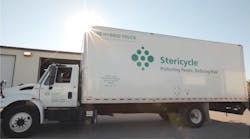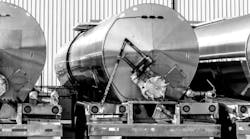COMPANY: Stericycle, Lake Forest, IL
OPERATION: Nationwide provider of document shredding services (about 1,800 drivers), medical/ biohazardous waste pickup and disposal (about 1,200 drivers) and compliance training
THE CHALLENGE: IMPROVE ON-SCHEDULE PICK-UP RATE
Stericycle was faced with a need: move the needle upward from the about 95% of on-schedule pickups for the company's medical waste disposal service that was the case in 2010. That business was the focus of a major routing and dispatch improvement project at Stericycle that's gone on through the 2010s.
Those last percentage points at the upper limit are the most difficult to get at, since it's moving from "very good" to essentially near-perfect. Well before talk of key performance indicators, or KPIs, that would be used for the project, there was a lot of attention paid to its underlying framework.
That was a key to the project success, and part of what was improved was the accuracy of data measured in the first place, explained John Shalaby, vice president of continuous improvement for Stericycle Compliance Services. The basic target for the performance-improvement project was to come up with better routing, boosting customer service and Stericycle's bottom line in the process.
The project required buy-in from all levels of the organization, Shalaby said, including senior leadership. Mid-level management such as regional vice presidents was just as important, since those execs would be in charge of facility operations and accountability, implementing and seeing to various changes.
But Stericycle also looked to its drivers. "We really wanted to get the drivers involved in the feedback of route plans," Shalaby said. "What we tried to do is say, ‘Alright, here's your plan that we came up with; tell us what works and what doesn't, and we'll take a look at it.'"
Before new technology was brought in as part of the equation, though, another imperative was to standardize processes like data capture, driver check-in and dispatch across Stericycle facilities.
THE SOLUTION: CHECK AND PERFECT KEY PERFORMANCE INDICATORS
Stericycle then turned to Omnitracs' Roadnet routing, dispatching, tracking and data analytics products. And it was now time to bring in those KPIs—though that was another reason the underlying project structural work was necessary.
"All of our KPIs were actual vs. planned," noted Casey Crawford, director of logistics at Stericycle. "So if you don't have a good plan — like we say our route is 12 hours and it's really eight — it doesn't do anybody much good."
The project looked at route hours, the time from when drivers depart a facility until they return. Route mileage was key in reducing distance and fuel consumption as much as possible. Stericycle also rolled in late starts, or drivers leaving even a little later than planned.
"People may not think of that much, but if a driver gets out 15 minutes late, it may cost 45 minutes or more on the road in traffic," Crawford explained. On a related note, the company examined "AM-PM time," or how long it takes drivers to arrive at work and then get on the road and arrive back at a facility and punch out.
Still another KPI Stericycle honed in on was "brake-to-brake time," he noted, and that's a driver's time at a stop providing services. It's a major part of the equation and amounts to about 50-60% of total route time, according to Crawford, and Roadnet's tools allowed the company visibility into when each truck stopped and started moving again.
After measuring the selected KPIs over 18 months, Crawford said, Stericycle saw a 38% improvement in brake-to-brake time. The company also cut the number of late starts by half. Overall mileage was reduced by 62%, and stops per hour—an overall efficiency indication Stericycle sought to maximize — increased by 80%.



